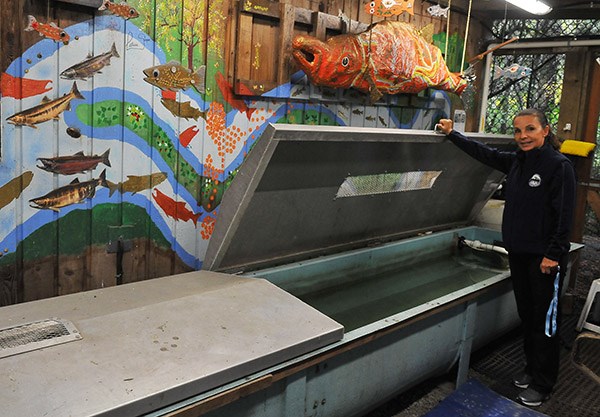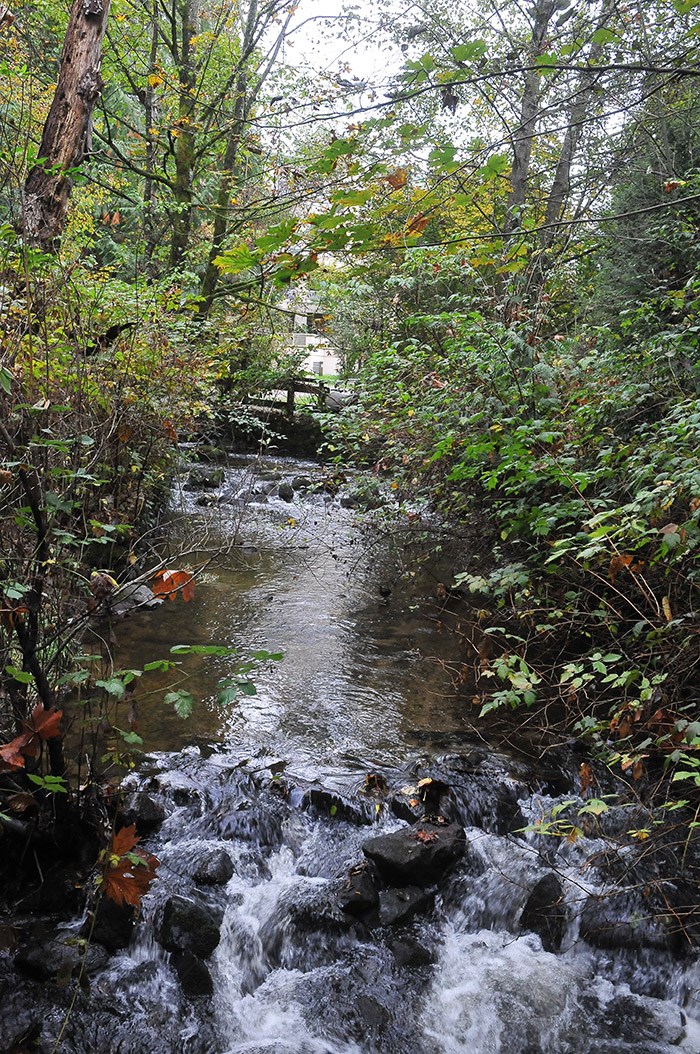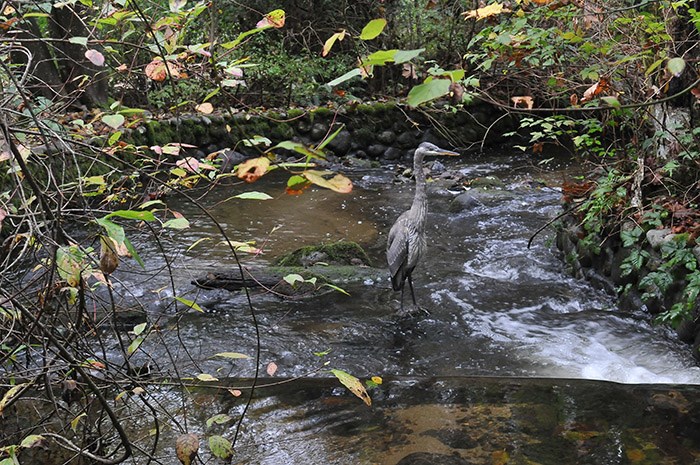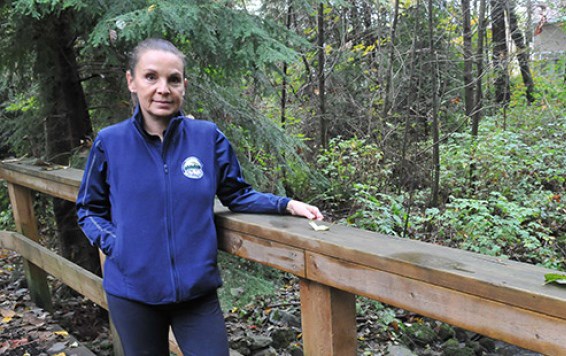There are few places that seem less likely for a salmon to travel from its ocean-going days to the twisting, gravel-lined place of its birth to spawn than the Hoy-Scott Creek watershed.
Yet it's exactly what happens, year after year, in the clear-running streams nestled among the sliver of forest that buffers this salmon habitat from the collection of condo buildings, schools and shopping malls that surround it. In fact, the coho population is returning in steady numbers and chum are also starting to appear, due in no small part to the dedicated work of volunteers with the Hoy-Scott Watershed Society.
Since the late 1990s, the group has been capturing spawning salmon, transporting them to the hatchery to incubate a new generation in stacks of trays before they get a taste of the wild life in the rearing pond and, each spring, are released into the creek.
Every day, volunteers check the air and stream temperatures, and conditions in the rearing pond, brush debris off the creek screens, and check the health of the stock.
But their work extends far beyond that, given the watershed's location in Coquitlam's bustling Town Centre and the unique challenges that presents.
"The city has grown up around the creek," said Robbin Whachell, the society's president, during a recent tour of the hatchery. "It's a gift, a jewel, but a lot of people live here and don't even know this is here."

Public education is one of the watershed's greatest priorities. From longtime local residents to new immigrants, many people don't know the streams in their backyard are salmon-bearing waterways and that the storm drains on their streets carry pollutants to the creeks, said Rodney Lee, the society's vice president.
"Individuals may come from places where you'd use a stream for drinking water, laundry and other household uses," Lee said. "Fish in the stream can be taken for food or display at any size. It's continued work to educate as new residents arrive all the time."
Visible from the hatchery office and incubation rooms are the four-storey condos that front on to Princess Crescent. The recess bells and sounds of children trickle in from nearby Walton elementary — Pinetree secondary and Douglas College are also a short walk away — while the peal of alarms can be heard from the Town Centre fire hall, which sits just above the hatchery's fish traps.

Walkers, runners, students and families keep the trails around the creek busy but all that traffic means garbage is left behind and dogs are let loose to run through the creek.
During particularly hot and dry summers, such as last year, the watershed is at risk from people tossing cigarette butts.
Invasive plants are a constant battle, whether it's pervasive species like the Himalayan blackberry or Japanese knotweed that were blocking the creek recently, Whachell said, or from neighbours dumping garden waste without realizing the impact it has on the survival of native species in the sensitive riparian area.
"Native plants provide shade cover, insect growth [as] food for fish, organic matter, bank stabilization with root structures, woody debris falling in-stream to create natural pools, water deflectors to reduce speed and resilience because of the diversity native plant species present as opposed to monoculture brought with invasive plant species," Lee said.
And while the trail traffic can present challenges, so does the ever increasing number of cars and construction surrounding the watershed.
Drivers snaking up and down Westwood Plateau likely don't know they are on roads that mimic Scott and Hoy creeks' path downstream to where they join near Rona and the park-and-ride lot at Coquitlam Central Station. Those idling in traffic on Lougheed Highway near Riverview can picture the path of Scott Creek as it runs parallel to the busy thoroughfare to reach the Coquitlam River near Orchid Drive.
In the spring of 2014, the society expressed concern with Evergreen Line crews that were working along the banks without proper sediment containment, and the following spring, hundreds of coho fry died in their incubation trays — roadway run-off was the suspected cause.
"Urbanization brings roadways and hard surfaces, which put rainwater runoff directly into storm drains and into the stream," Lee said. That means water levels rise and fall quickly, with wide fluctuations in creek volume.
In the summer, low-flow water conditions present a significant concern to fish health, Lee added, but it's hoped that upgrading storm drain infrastructure and changing hard surfaces to more water-permeable materials will help.
Fortunately, Lee said, incidents like the one in March 2015 are rare and the streams' health is good considering its urban location.
"There are healthy populations of pollution-intolerant species — mayflies, caddisflies, stoneflies — which serve as a good indicator and also serve well as food for fish," he said.

The result of all that diligent habitat restoration and protection is a stream system bustling with fish.
Records kept since 2003 show volunteers trapped 42 coho that year. Four years later, only nine were trapped for the hatchery, with the high in 2013 being 154.
There are now three generations of hatchery fish that are marked with clipped adipose fins so that volunteers can collect return data to gauge the survivability of their fish and estimate population sizes; in 2013 they released about 1,800 clipped coho smolts and, with their three-year life cycle, Lee said they are expecting a sizeable return year.
The group is also starting to raise chum salmon after obtaining grant funding from the Pacific Salmon Foundation and equipment from Fisheries and Oceans Canada to maintain a mix of salmon species in the Hoy-Scott creek system.
"Each returning salmon brings ocean biomass and nutrients back to the freshwater stream to help things grow," Lee said. "Dead adults are food for terrestrial scavengers, fish fertilizer for streamside plants, decay in-stream is food for overwintering coho juveniles. The different run timing means there are carcasses in the stream longer, providing a longer availability for food."
But all of it requires constant, diligent protection, Whachell and Lee agreed. Neighbourhoods surrounding the watershed were built many years ago but as Coquitlam continues to grow, it needs to be in accordance with better development practices that preserve the natural hydrology as much as possible.
More people, more pollution and improper stream-use practices can negatively affect its health for decades to come, Lee said.
"Think big things you can see, like fish, but also the small stuff that help build up the food web to support those fish."
Mitigating those risks comes from public education — at the Salmon Come Home and Salmon Leave Home events each year and ongoing school and community group tours — public presence and volunteer engagement. But the society is hoping the public can do their part as well, keeping their eyes out for the watershed's health and reporting to authorities if necessary, Lee said.
"We collectively as the public have a duty of care and stewardship for the streams."
SALMON COME HOME
This weekend the Hoy-Scott Watershed Society celebrates its signature event to welcome spawning salmon back home.
Salmon Come Home is on Oct. 23, from 11 a.m. to 3 p.m., rain or shine. Each year thousands are drawn to the event, which features free family fun including music and crafts, children's costume parade and storytelling, information on the watershed and, of course, a chance to see salmon spawning.
The hatchery is located in Hoy Creek Park, behind the City Centre Aquatic Complex at Pinetree and Guildford ways. Free parking is available at city hall, Pinetree community centre and Douglas College.
Visit www.hoyscottcreeks.org for more information.



